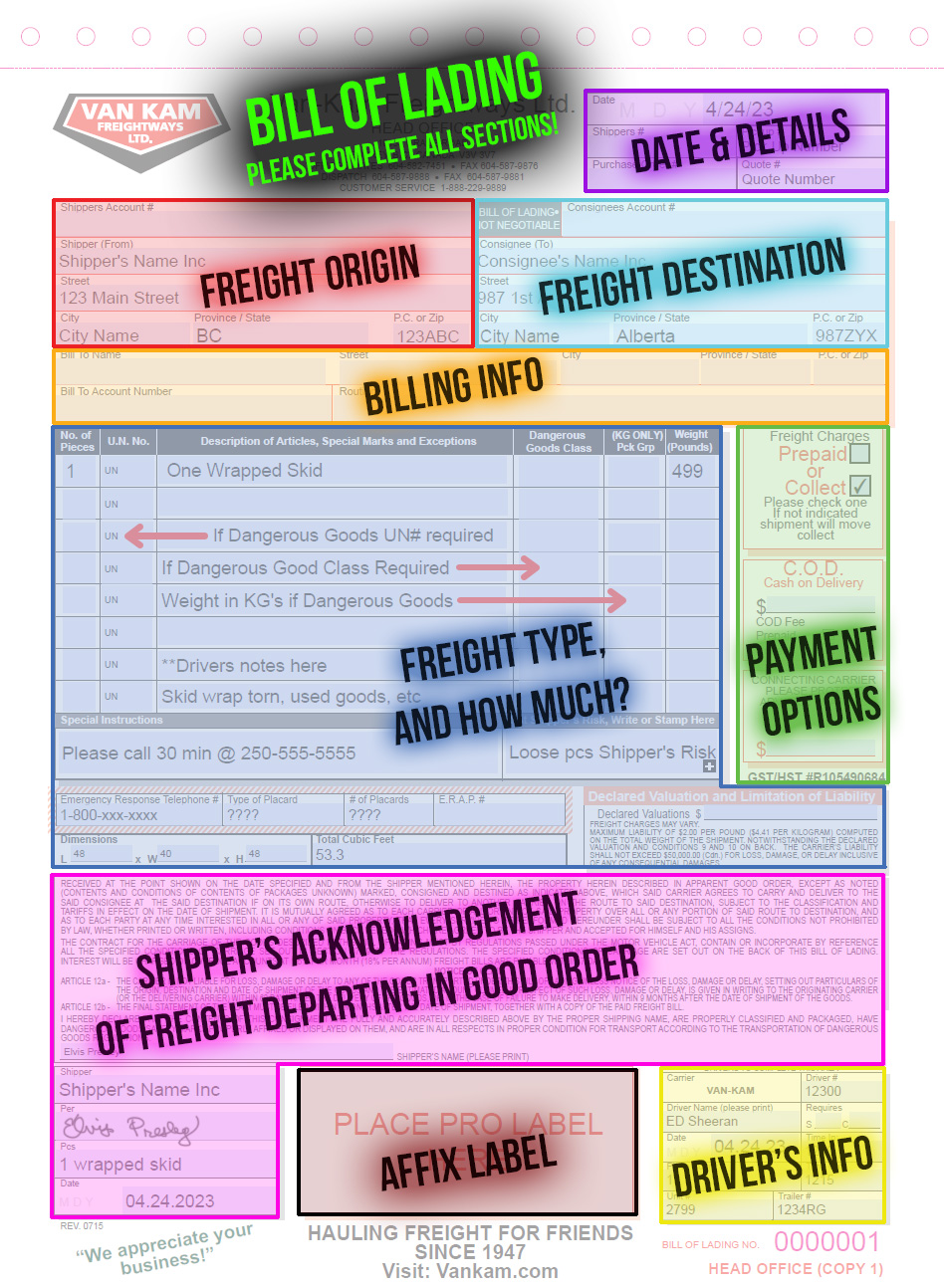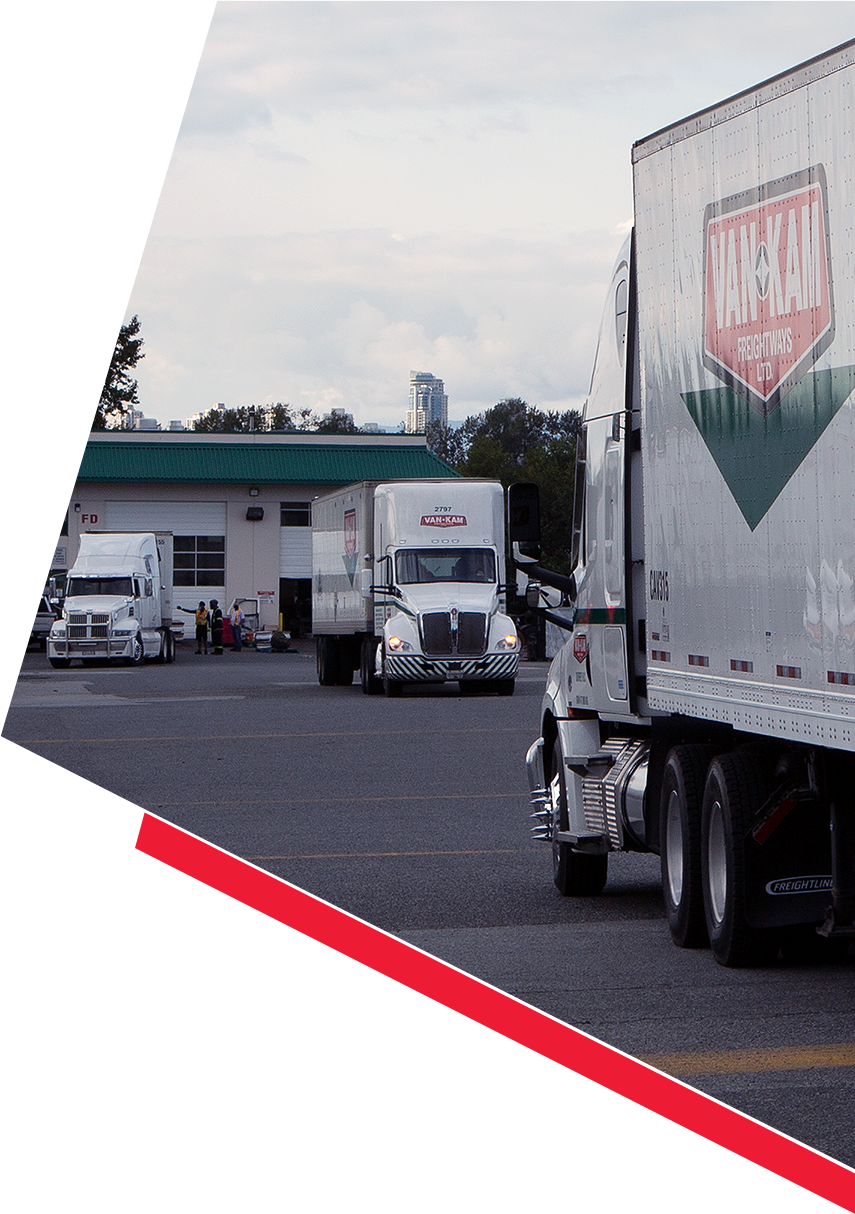HOW TO COMPLETE A BILL OF LADING
View Completed BOL Example HereTo ensure your shipment arrives at the right place, at the right time and at the right price, the BOL must be completed correctly. When all information is properly filled in, we’re able to move your shipment through our system efficiently to avoid any administrative delays, billing errors or misrouting.
To complete the Van Kam Freightways Ltd. Bill of Lading, simply refer to these guidelines:
- Date – Record the date the shipment is given to Van Kam Freightways Ltd.
- Shipper # – The account number of the shipper.
- Pickup # – The Pickup # assigned for the shipment.
- Purchase Order # – Your own Purchase Order #.
- Quote # – For customers who do not have a tariff and have called for a one-time shipment price. Quote #s must be added to the BOL for it to be valid and to ensure correct billing.
- Shipper’s Account # – Enter the Shipper’s Account #, full name and complete address including postal code.
- Consignee’s Account # – Enter the Consignee’s Account # if known, full name of consignee and complete delivery address including postal code. A P.O. box is not a valid consignee address.
- Bill to Name – The name of the company paying for the shipment.
- Bill to Account # – The account # of the company that is paying for the shipment.
- Routing – If applicable, specify the beyond carrier, otherwise the shipment is interlined with our preferred carrier.
- No. of Pieces – Total pieces being shipped (i.e. 5 pallets).
- Description of Articles, Special Marks and Exceptions – Describe the contents of the shipment in full. If a 1-pallet shipment contains 24 cartons, specify this piece count in the description. Indicate the contents of the shipment (i.e. transmission, newspapers etc.).
- Dangerous Goods: Class, U.N. #, Packaging Group – Indicate the Dangerous Goods information for the shipment here (Packaging Group is always written in Roman numerals: PG 1, PG 11, PG 111).
- Weight – For general freight, enter the total shipment weight in pounds. If shipping dangerous goods, enter in kilograms.
- Special Instructions – Any special requirements for the successful delivery of the freight (i.e. power tailgate, call for appointment, protect from freezing). Additional charges as stated in the Terms & Conditions may apply.
- If At Shipper’s Risk – Personal effects are shipped at owner’s risk of damage.
- Freight Charges – Circle Prepaid if the shipper is paying for the shipment. Circle Collect if the consignee is paying.
- C.O.D. – The dollar amount to be collected is indicated. Select either Prepaid or Collect.
- Connecting Carrier Please Protect Advance Charges – The charges from the first carrier moving the freight from Point A to B are specified here. The “connecting carrier” now moving the freight from B to C (destination) is for an additional charge. The total charge for the interline shipment is to be collected from the consignee. Stating the charge for the first leg of the shipment ensures correct billing for total shipment cost from shipper location to consignee.
- Emergency Response Telephone # – Provide a contact # of an emergency response company that is available 24/7.
- Type of Placard, # of Placards – As required by Transport Canada for the particular class of dangerous goods shipped. Currently not required by shipper to complete. Van Kam Freightways Ltd. will placard each trailer according to Transport Canada requirements prior to departure.
- E.R.A.P. # – Emergency Response Assistance Plan # – An approved E.R.A.P. is required by the carrier transporting certain dangerous goods above a quantity specified in Column 7 of Schedule I of the Transport of Dangerous Goods Regulations.
- Dimensions – Record the length, width, height of the shipment.
- Total Cubic Feet – Multiply the L x W x H and divide by 1728 to calculate the total cubic feet of the shipment.
- Shipper – Complete signing name, indicating piece count and date given to Van Kam Freightways Ltd.




